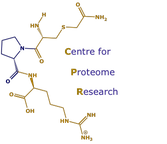Quantification
What capabilities do you have?
14/05/15 09:43
We have an extensive suite of instrumentation. These instruments have all been brought into CPR by grants awarded to Rob and Claire (with other colleagues) and are primarily directed towards the research programmes that they have to support. However, we are very willing to engage with other groups, as collaborators or in the context of the Shared Rsearch Facility.
• 2006: Waters GC-TOF Premier GS/MS system
• 2009: Waters Xevo QqQ/nanoAcquity
• 2009: Waters Xevo QqQ/nanoAcquity
• 2010: Thermo Velos Orbitrap/nanoAcquity (upgraded to Elite in 2015 for metabolomics)
• 2010: Waters Synapt G2/nanoAquity high resolution ion mobility QToF
• 2010: Bruker Amazon high speed ion trap/nanoAcquity
• 2010: Bruker Ultraflex Extreme 1kHz MALDI-TOF/TOF
• 2012: Thermo QExactive Orbitrap instrument/Dionex u3000 nano
• 2013: Waters G2si IM-QTOF for intact protein research
• 2013: Waters G2si IM-QTOF/ nanoAquity for proteomics
• 2013: Waters Xevo TQS QqQ/nanoAcquity
• 2014: Waters MALDI-Synapt G2si imaging system
• 2014: Waters LAESI-Synapt G2si imaging system, upgrade to include DESI in 2015
• 2015: Thermo Fusion tribrid mass spectrometer
• 2015: Thermo QExactive HF mass spectrometer
• 2015: Access to Fluidigm CyTOF mass cytometer
.
• 2006: Waters GC-TOF Premier GS/MS system
• 2009: Waters Xevo QqQ/nanoAcquity
• 2009: Waters Xevo QqQ/nanoAcquity
• 2010: Thermo Velos Orbitrap/nanoAcquity (upgraded to Elite in 2015 for metabolomics)
• 2010: Waters Synapt G2/nanoAquity high resolution ion mobility QToF
• 2010: Bruker Amazon high speed ion trap/nanoAcquity
• 2010: Bruker Ultraflex Extreme 1kHz MALDI-TOF/TOF
• 2012: Thermo QExactive Orbitrap instrument/Dionex u3000 nano
• 2013: Waters G2si IM-QTOF for intact protein research
• 2013: Waters G2si IM-QTOF/ nanoAquity for proteomics
• 2013: Waters Xevo TQS QqQ/nanoAcquity
• 2014: Waters MALDI-Synapt G2si imaging system
• 2014: Waters LAESI-Synapt G2si imaging system, upgrade to include DESI in 2015
• 2015: Thermo Fusion tribrid mass spectrometer
• 2015: Thermo QExactive HF mass spectrometer
• 2015: Access to Fluidigm CyTOF mass cytometer
.
What is the lowest limit of detection you can attain?
14/05/15 09:41
We would hope to be able to reach 100 attomol for the lowest abundance in a discovery experiment.
To know whether that is enough, let's do some quick calculations.
A detection limit of 100 attomol is equivalent to injecting 60 million molecules into the mass spectrometer - that sounds like a lot. If the sample was derived from yeast cells, we would have loaded of the order of 200,000 yeast cell equivalents onto the same column. Thus, we can measure 60 million molecules, derived from 200,000 cells. From this, you will see that the limit of detection in an unprocessed sample is 60,000,000/200,000 = 300 copies per cell.
That sounds pretty good, right? But, if we have been using HeLa cells, the numbers are very different. The limit to what can be loaded on the hplc column is dictated by the total protein load - 200,000 cells gives us about 1000 nanograms of protein. However, each HeLa cell would contain 50 times as much protein as a yeast cell, approximately. Therefore, for a 1000 ng column capacity, we can only load about 4,000 HeLa cells equivalent onto the column. For the same detection limit of 100 attomol, we obtain a limit of detection of 60,000,000/4,000 copies per cell, or 15,000 copies per cell. Rather different!
To overcome such difficulties, it is necessary to resort to sample prefractionation and concentration steps, which have the potential to introduce 'lossy' steps but also increase the number of subsequent LC-MS/MS analyses that need to be conducted, and hence the cost.
To know whether that is enough, let's do some quick calculations.
A detection limit of 100 attomol is equivalent to injecting 60 million molecules into the mass spectrometer - that sounds like a lot. If the sample was derived from yeast cells, we would have loaded of the order of 200,000 yeast cell equivalents onto the same column. Thus, we can measure 60 million molecules, derived from 200,000 cells. From this, you will see that the limit of detection in an unprocessed sample is 60,000,000/200,000 = 300 copies per cell.
That sounds pretty good, right? But, if we have been using HeLa cells, the numbers are very different. The limit to what can be loaded on the hplc column is dictated by the total protein load - 200,000 cells gives us about 1000 nanograms of protein. However, each HeLa cell would contain 50 times as much protein as a yeast cell, approximately. Therefore, for a 1000 ng column capacity, we can only load about 4,000 HeLa cells equivalent onto the column. For the same detection limit of 100 attomol, we obtain a limit of detection of 60,000,000/4,000 copies per cell, or 15,000 copies per cell. Rather different!
To overcome such difficulties, it is necessary to resort to sample prefractionation and concentration steps, which have the potential to introduce 'lossy' steps but also increase the number of subsequent LC-MS/MS analyses that need to be conducted, and hence the cost.
